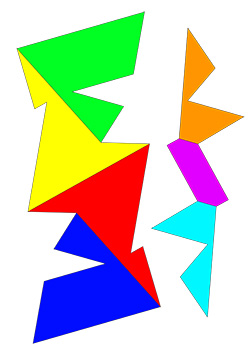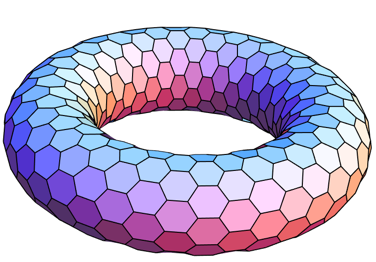[Questo post è in inglese. Leggi qui la versione italiana]
The most well-known polyhedra, fo sure, are the regular ones, also called platonic: tetrahedra, octahedra, cubes, icosahedra, and dodecahedrons.
They are made of triangles, squares and pentagons... But can we make one out of hexagons?
The answer is no, at least if we want them to be equal and regular. This follows from the fact that putting three hexagons side by side, takes up the whole 360° angle (120° each one), and we can't bend them to make something three-dimensional.
The triangles take up the whole angle too, but we need six of them to do it. So, with only three, four or five we can create polyhedra: the tetrahedron, the octahedron and the icosahedron respectively.
What if we settle to only have some faces that are hexagons? In this case, we can construct polyhedra. For example, using pentagons, we can make a truncated icosahedron, which is the football's ball.
But let's suppose that we want all the faces to be hexagons.
Maybe it suffices to take them not regular? For example, there exists only one polyhedron made of squares (that is, regular quadrilaterals): the cube; but, if we don't ask them to be regular, there are others, one of them is the rhombic icosahedron. Then, maybe, there are no polyhedra made of regular hexagons, but there are made of irregular ones.
The answer, sadly, is always no!
Using Euler's formula for polyhedra, that says
vertices + faces = edges + 2 ,
(that is, the number of vertices, added to the number of faces, is equal to the number of edges plus two) one can prove that you can't construct a polyhedron made only of hexagons, it doesn't matter if regular or not!
This is very sad news for polyhedra and hexagons lovers :(
But don't worry! Nothing is over!
Euler's formula is only true for polyhedra that are "balls", which means that they have no holes. But Euler's formula for donut-polyhedra is different:
vertices + faces = edges .
Thus, we can present a polyhedron made only of hexagons! Ladys and gentelmans... the Szilassi's polyhedron!
It has seven faces, all hexagonal. Each face has six edges and thus touches all the other faces. Six of those faces are concave hexagons, equal in pairs. The last one is a convex hexagon, the only one, and it is "in the hole".
This is its net:
Unfortunately, someone may say that concave hexagons are ugly.
I disagree. But, for those people, we'll search if it is possible to have a polyhedron made only of convex hexagons.
Searching on the internet, one can find this picture: a donut polyhedron exactly as we search it.
But... there is something wrong. This polyhedron can't exist! This is why:
We say that our polyhedron has n hexagonal faces.
Then, its edges are 3n, because every face has 6 edges, and every edge belongs to two faces.
Take now Euler's formula for donut polyhedra: vertices + faces = edges, then, soubstituting faces = n and edges = 3n, we obtain vertices = 2n.
Every face has 6 vertices, so every vertex must belong (on average) to 3 faces (it's the same argument as made before with edges). But, in a vertex, we can't have less than 3 faces, that is the same thing as saying: a vertex can't belong to less than 3 faces.
Thus, in every vertex, there are exactly 3 faces.
(Note: this is true for Szilassi's polyhedron, which is an example of a donut polyhedron with hexagonal faces)
We'll see now that, if the faces are convex hexagons, this is impossible!
The sum of the angles of a (convex) hexagon is 6x120°. Thus, each angle of each hexagon is, on average, 120°, thus, each vertex, on average, has a total of 3x120° = 360°.
Here is the problem: if I have three faces that meet in a vertex and their angles are less than 180° (because the hexagons are convex), then the total sum of these angles can't be more or equal than 360°. This is true for every polyhedron you can think of (this is not a proof, but if you want to convince yourself try moving the points A, B and C here, and watch how the angle sum change); and one can prove it without too much trouble, but I will not do it here.
This means that in all the vertices, there are less than 360°, which is in contradiction with what was said before: on average, there are 360°.
Having a contradiction, a donut polyhedron made only of convex hexagons (as the one in the picture) cannot exist...
❒
So, the picture found on the internet is trying to fool us: probably, the hexagons on the inside are not planar, but we can't see it from far away.
Let us return to our initial question: can we find a polyhedron made only of convex hexagons? The answer is no if it is a sphere (for Euler's formula) and no again if it is a donut, but maybe, adding holes to our donut... Maybe!
(Note: when I say "maybe", I really mean it! As far as I know, this is an open question in math: nobody knows the answer.)






